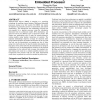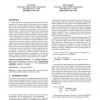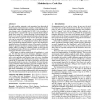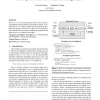905 search results - page 11 / 181 » Code Generator Testing in Practice |
SAC
2008
ACM
13 years 9 months ago
2008
ACM
Software-based self-test (SBST) is emerging as a promising technology for enabling at-speed testing of high-speed embedded processors testing in an SoC system. For SBST, test rout...
EMSOFT
2008
Springer
13 years 11 months ago
2008
Springer
C's volatile qualifier is intended to provide a reliable link between operations at the source-code level and operations at the memorysystem level. We tested thirteen product...
POPL
2009
ACM
14 years 10 months ago
2009
ACM
We study modular, automatic code generation from hierarchical block diagrams with synchronous semantics. Such diagrams are the fundamental model behind widespread tools in the emb...
ACSAC
2006
IEEE
14 years 3 months ago
2006
IEEE
Attack graphs are a valuable tool to network defenders, illustrating paths an attacker can use to gain access to a targeted network. Defenders can then focus their efforts on patc...
OOPSLA
2007
Springer
14 years 4 months ago
2007
Springer
RANDOOP FOR JAVA generates unit tests for Java code using feedback-directed random test generation. Below we describe RANDOOP’s input, output, and test generation algorithm. We ...




